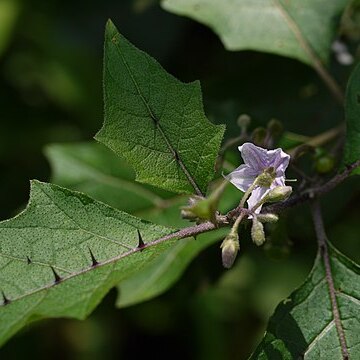Slender shrub, up to 2 m high; vegetative parts and calyx with stellate indumentum; ± armed. Prickles straight, thin, straw-coloured, up to 8 mm long. Leaves elliptic-ovate, up to 200 x 100 mm, entire to sinuate, prickles few; petioles up to 60 mm long. Inflorescence racemose, 1-10-flowered; peduncle up to 6 mm long; pedicels 4-15 mm long. Calyx hairy, up to 4 mm long, deeply lobed, lobes ± triangular. Corolla ± 10 mm long, 9-13 mm in diam., deeply lobed; lobes lanceolate, stellate hairs outside, white to mauve. Flowering time Nov.-May. Fruit ± globose, juicy, up to 15 mm in diam., smooth, white or green, ripening orange to red; pedicel 8-15 mm long, mostly erect. Seeds ± ovate, compressed, up to 2 x 3 mm, finely pitted, light brown.
Cymes mostly lateral, leaf-remote, unbranched or occasionally once forked, generally racemiform, (2)4–20(25)-flowered, usually all flowers hermaphrodite and fertile, widely and ± equally spaced often on a well developed rhachis, occasionally the flowers sub-umbelliform or solitary, tomentose to minutely hairy, sometimes with purplish hairs; peduncle up to 3 cm long, prickly to quite unarmed; pedicels 3–9 mm long, slender, thickened and occasionally prickly distally, erect or ± curved, in fruit elongated to 15 mm, stouter, erect to deflexed.
A shrub. It grows 1 m high. It has irregular branches. They are slightly woody. There are short prickles on the stems and leaf veins. The leaves are oval and some deep triangle shaped lobes on each side. The leaves are 15 cm long by 10 cm wide. The flowers are in compact groups of 12 small flowers. They are mauve or white. The fruit are small orange or red berries. They are 1 cm across.
Erect to spreading, woody herb, shrub or very rarely a small tree to 4(5) m, usually armed; hairs stellate, sessile or shortly stalked, with short to long rays, the central ray sometimes longer; prickles yellowish to brownish or occasionally dark purple basally, few to many, straight or somewhat recurved, up to 13 mm long and 5 mm wide at the base, ± hairy to glabrous.
Calyx purple, violaceous or maroon, tomentose to moderately hairy, unarmed or occasionally prickly; tube 1–3 mm long, shortly campanulate or cupular; lobes ± unequal, 0.5–2.5 × 0.5–1.7 mm, shortly triangular to oblong-cuspidate or linear, obtuse or acute to long-acuminate, sparingly hairy inside.
Corolla white tinged pink, purple to blue outside, sometimes so only proximally, 8–18(20) mm across, ± stelliform; lobes 3.5–9 × 1.5–4 mm, ovate-lanceolate to linear, acute, densely hairy or hairy only on median region and apex outside and less so to subglabrous inside.
Spiny shrub, 0.5-3.0 m high. Spines straight. Leaves deeply pinnatisect, sparsely stellate-pubescent above, densely so beneath. Inflorescence a few-flowered cyme. Corolla 9-13 mm in diameter. Berry red or orange. Flowers pale violet, white.
Fruit at first green, later yellow to red, glossy, turning brown or blackish with age, 6–12(13) mm in diameter, globose, occasionally with a few hairs near the top, 2–3-locular, fleshy and edible when mature, easily detached.
Ovary c. 1 mm in diameter, ± globose, glabrous or with a few hairs near the top; style 6–8 mm long, straight or slightly curved at the apex, usually hairy on lower three quarters.
Seeds whitish to yellowish, more rarely orange to light purple, 2–3 × 1.5–2.8 mm, lenticular-reniform or oblong to discoid, verruculous-rugose to minutely pitted all over.
Stamen filaments 0–1.5 mm long; anthers 3–6 mm long, linear-oblong or lanceolate in outline, cordate basally, ± straight.
Branches occasionally purplish tinged, tomentose, tardily glabrescent, usually with scattered prickles.
Flowers (4)5-merous.


